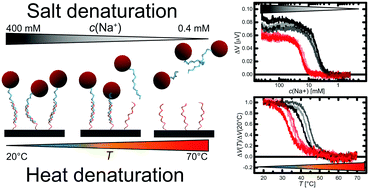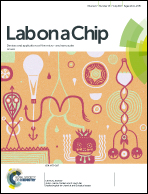Two-dimensional salt and temperature DNA denaturation analysis using a magnetoresistive sensor†
Abstract
We present a microfluidic system and its use to measure DNA denaturation curves by varying the temperature or salt (Na+) concentration. The readout is based on real-time measurements of DNA hybridization using magnetoresistive sensors and magnetic nanoparticles (MNPs) as labels. We report the first melting curves of DNA hybrids measured as a function of continuously decreasing salt concentration at fixed temperature and compare them to the corresponding curves obtained vs. temperature at fixed salt concentration. The magnetoresistive sensor platform provided reliable results under varying temperature as well as salt concentration. The salt concentration melting curves were found to be more reliable than temperature melting curves. We performed a two-dimensional mapping of the melting profiles of a target to probes targeting its wild type (WT) and mutant type (MT) variants in the temperature–salt concentration plane. This map clearly showed a region of optimum ability to differentiate between the two variants. We finally demonstrated single nucleotide polymorphysm (SNP) genotyping using both denaturation methods on both separate sensors but also using a differential measurement on a single sensor. The results demonstrate that concentration melting provides an attractive alternative to temperature melting in on-chip DNA denaturation experiments and further show that the magnetoresistive platform is attractive due to its low cross-sensitivity to temperature and liquid composition.



 Please wait while we load your content...
Please wait while we load your content...